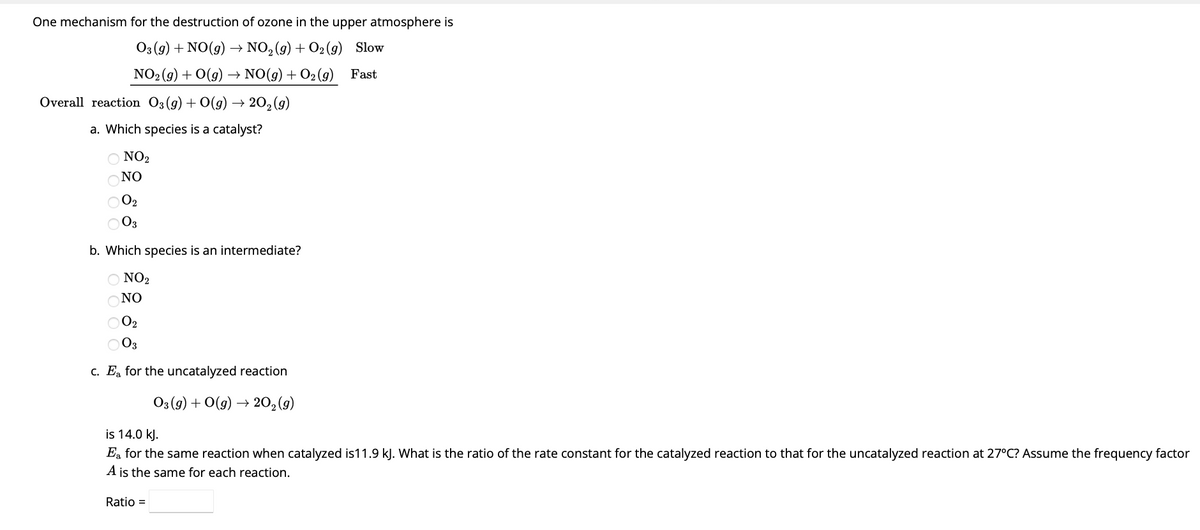One mechanism for the destruction of ozone in the upper atmosphere is 03(g) + NO(g) → NO₂(g) + O₂(g) Slow NO₂(g) + O(g) → NO(g) + O2(g) Fast Overall reaction O3(g) + O(g) → 20₂ (9) a. Which species is a catalyst? O NO2 NO 0₂ 03 b. Which species is an intermediate? O NO2 NO 0₂ 03 c. Ea for the uncatalyzed reaction O3(g) + 0(g) → 20₂ (9) is 14.0 kJ. E for the same reaction when catalyzed is11.9 kJ. What is the ratio of the rate constant for the catalyzed reaction to that for the uncatalyzed reaction at 27°C? Assume the frequency factor A is the same for each reaction. Ratio =
One mechanism for the destruction of ozone in the upper atmosphere is 03(g) + NO(g) → NO₂(g) + O₂(g) Slow NO₂(g) + O(g) → NO(g) + O2(g) Fast Overall reaction O3(g) + O(g) → 20₂ (9) a. Which species is a catalyst? O NO2 NO 0₂ 03 b. Which species is an intermediate? O NO2 NO 0₂ 03 c. Ea for the uncatalyzed reaction O3(g) + 0(g) → 20₂ (9) is 14.0 kJ. E for the same reaction when catalyzed is11.9 kJ. What is the ratio of the rate constant for the catalyzed reaction to that for the uncatalyzed reaction at 27°C? Assume the frequency factor A is the same for each reaction. Ratio =
Chemistry: An Atoms First Approach
2nd Edition
ISBN:9781305079243
Author:Steven S. Zumdahl, Susan A. Zumdahl
Publisher:Steven S. Zumdahl, Susan A. Zumdahl
Chapter11: Chemical Kinetics
Section: Chapter Questions
Problem 75E: One mechanism for the destruction of ozone in the upper atmosphere is a. Which species is a...
Related questions
Question

Transcribed Image Text:One mechanism for the destruction of ozone in the upper atmosphere is
O3(g) + NO(g)
NO₂(g) + O₂(g) Slow
NO₂(g) + O(g) → NO(g) + O₂(g) Fast
Overall reaction O3(g) + O(g) → 20₂ (g)
a. Which species is a catalyst?
NO2
NO
002
03
b. Which species is an intermediate?
O NO2
NO
002
03
c. Ea for the uncatalyzed reaction
O3(g) + 0(g) → 20₂ (g)
is 14.0 kJ.
Ea for the same reaction when catalyzed is11.9 kJ. What is the ratio of the rate constant for the catalyzed reaction to that for the uncatalyzed reaction at 27°C? Assume the frequency factor
A is the same for each reaction.
Ratio =
Expert Solution
This question has been solved!
Explore an expertly crafted, step-by-step solution for a thorough understanding of key concepts.
This is a popular solution!
Trending now
This is a popular solution!
Step by step
Solved in 4 steps with 1 images

Knowledge Booster
Learn more about
Need a deep-dive on the concept behind this application? Look no further. Learn more about this topic, chemistry and related others by exploring similar questions and additional content below.Recommended textbooks for you

Chemistry: An Atoms First Approach
Chemistry
ISBN:
9781305079243
Author:
Steven S. Zumdahl, Susan A. Zumdahl
Publisher:
Cengage Learning


Chemistry
Chemistry
ISBN:
9781305957404
Author:
Steven S. Zumdahl, Susan A. Zumdahl, Donald J. DeCoste
Publisher:
Cengage Learning

Chemistry: An Atoms First Approach
Chemistry
ISBN:
9781305079243
Author:
Steven S. Zumdahl, Susan A. Zumdahl
Publisher:
Cengage Learning


Chemistry
Chemistry
ISBN:
9781305957404
Author:
Steven S. Zumdahl, Susan A. Zumdahl, Donald J. DeCoste
Publisher:
Cengage Learning

Chemistry & Chemical Reactivity
Chemistry
ISBN:
9781337399074
Author:
John C. Kotz, Paul M. Treichel, John Townsend, David Treichel
Publisher:
Cengage Learning

Chemistry & Chemical Reactivity
Chemistry
ISBN:
9781133949640
Author:
John C. Kotz, Paul M. Treichel, John Townsend, David Treichel
Publisher:
Cengage Learning

Chemistry for Engineering Students
Chemistry
ISBN:
9781337398909
Author:
Lawrence S. Brown, Tom Holme
Publisher:
Cengage Learning